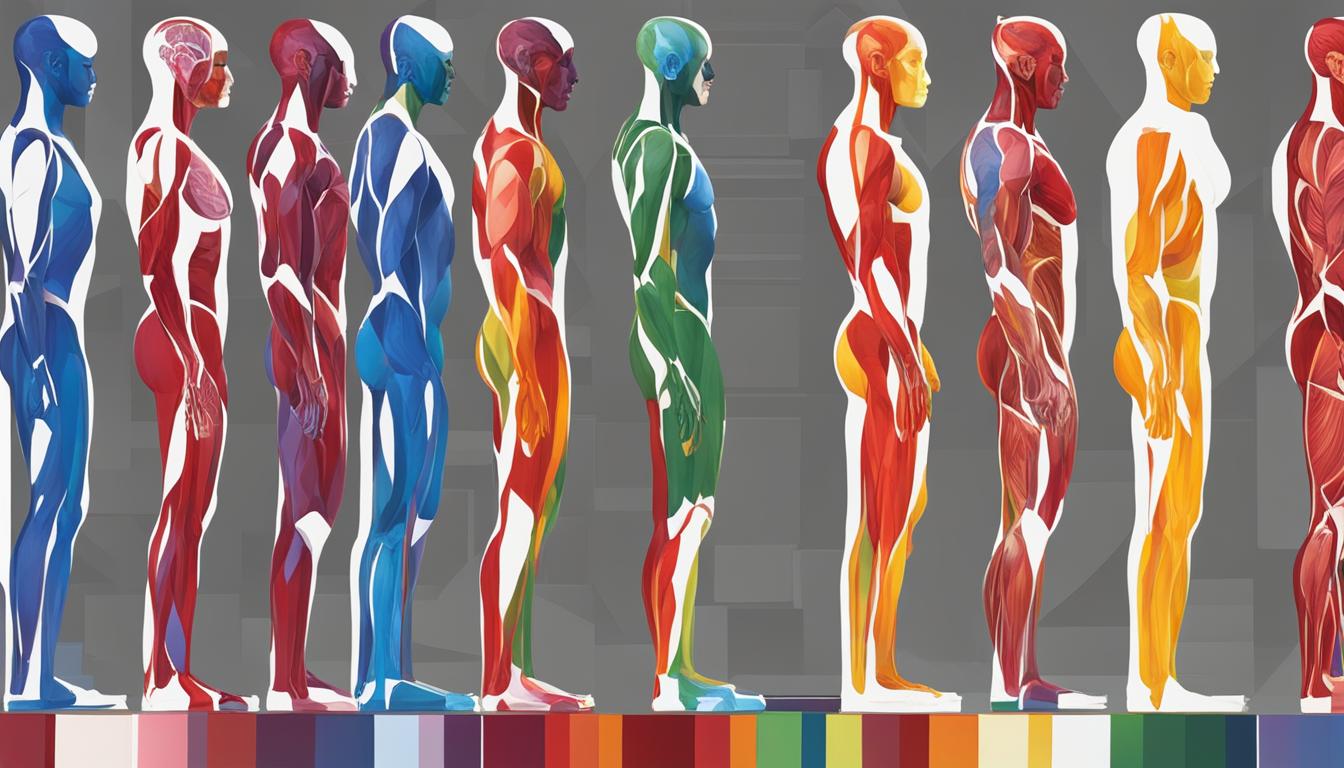When it comes to achieving your fitness goals, there’s no one-size-fits-all approach. Each of us is unique, with different body types and genetic makeup. That’s why tailoring your workout plan to your specific body type is so important. It allows you to optimize your fitness results, ensuring that you’re getting the most out of your efforts.
Personalized workout plans based on body type are designed to take into account your individual needs and characteristics. Whether you’re an endomorph, ectomorph, or mesomorph, understanding your body type can help you create a fitness program that works best for you. By considering your body’s strengths and weaknesses, you’ll be able to develop effective workout routines that target specific areas and address your unique challenges.
So, how do you go about tailoring your workout to your body type? This practical guide will walk you through the process, providing you with valuable insights and tips to help you achieve your desired physique. From identifying your body type to understanding the link between genetics and muscle growth, we’ll cover everything you need to know to create a workout plan that works in harmony with your body.
Key Takeaways:
- Understanding your body type is essential for creating a personalized workout plan.
- There are three main body types: endomorph, ectomorph, and mesomorph.
- Genetics play a significant role in muscle growth and development.
- Eating right based on your body type can optimize your fitness journey.
- Tailoring your workouts to your body type can maximize your results.
Understanding Your Body Type: How We’re Made
Before diving into body type workouts, it’s important to understand how we’re made. Our body type is determined by factors such as genetics and bone structure.
There are three main body types: endomorph, ectomorph, and mesomorph. Each of these body types has unique characteristics and traits.
Endomorphs have a higher body fat percentage and are more likely to store fat. They may have a softer and rounder appearance.
Ectomorphs have trouble gaining weight, whether it be muscle or fat, due to a high metabolism. They often have a lean and slender build.
Mesomorphs have a “V” shape with broad shoulders and a tight waist. They tend to have a naturally muscular physique and find it easier to build muscle.
It’s important to note that it’s also possible to have a combination of these body types. Understanding your body type can help you tailor your workouts and nutrition to achieve the best results for your individual needs.
By considering your genetics and body type, you can create a more effective workout plan that is specifically tailored to your unique needs and goals.
The Link Between Genetics and Muscle Growth
Genetics play a significant role in determining our muscle growth and overall strength. Certain genes can have a direct impact on how our muscles develop and respond to training. To gain a better understanding of your genetic potential and optimize your strength training routine, consider genetic testing.
Genetic testing provides valuable insights into how your body is genetically predisposed to respond to different types of exercise and training methods. By analyzing your genetic makeup, these tests can help identify specific gene variations that may influence your muscle growth and strength potential. Armed with this knowledge, you can tailor your workouts to target areas of genetic advantage and address any potential limitations.
Genetic testing can offer you valuable information about your body’s unique potential for strength training and muscle growth.
Unlock Your Full Potential with Genetic Testing
Understanding the link between genetics and muscle growth can revolutionize your strength training journey. Genetic testing can motivate you by revealing your innate strengths and highlighting areas where you may need to focus more effort. Armed with this knowledge, you can set realistic strength goals and design personalized training sessions that cater to your genetic predispositions.
In addition to setting goals, genetic testing can also help you track your progress more effectively. By periodically retesting and comparing your results, you can gauge the effectiveness of your training program and make necessary adjustments to continue progressing towards your desired outcomes.
Genetic testing is an excellent tool to unlock your full potential in the gym and achieve your desired muscle growth and strength gains.
Optimizing Your Strength Training with Genetic Insights
With genetic insights in hand, you can optimize your strength training routine by focusing on exercises and training methods that align with your genetic predispositions. For example, if your genetic profile indicates you have a higher potential for explosive or power-based movements, incorporating exercises like Olympic lifts or plyometrics can be beneficial.
“Understanding your genetic profile allows you to refine your strength training routine, targeting areas where you have a genetic advantage and working on areas that may require additional attention.” – Dr. Sarah Johnson, Geneticist
By utilizing your genetic insights, you can develop a personalized training program that maximizes your strengths, minimizes weaknesses, and prevents potential injury. This targeted approach allows you to make the most of your training time and effort, leading to faster and more noticeable muscle growth and strength gains.
Your genetic profile is the key to unlocking your full potential in strength training, enabling you to create a personalized workout program for optimal results.
Developing a Workout Plan Based on Genetics
Unlocking your fitness potential is now possible with the help of DNA fitness testing. By analyzing your genetic makeup, these tests provide valuable insights into how your genes relate to fitness. Through genetic testing, you can gain a deeper understanding of your genetic potential, identify specific genetic variations that may affect your fitness journey, and create a personalized workout plan tailored to your unique genetic profile.
Designing a workout plan based on your genetic testing results can have a significant impact on your motivation and potential for success. Armed with knowledge about your genetic advantages and potential limitations, you can develop targeted workout routines that maximize your strengths and address any areas of weakness.
With a personalized workout plan, you can optimize your training program to align with your genetic blueprint. By focusing on exercises and training methods that align with your genetic profile, you can enhance your body’s response to exercise and achieve better results.

DNA fitness testing can help you develop a personalized workout plan based on your genetic testing results.
The Power of Personalization
“When you tailor your workouts to your genetics, you’re giving yourself the best chance of success. It’s like having a roadmap that guides you towards your fitness goals,” says Dr. Rachel Thompson, a leading expert in genetic fitness testing.
By leveraging the insights gained from genetic testing, you can approach your workouts with a renewed sense of purpose and motivation. The knowledge that you are customizing your fitness routine specifically for your genetic composition can instill a sense of confidence and belief in your abilities.
Moreover, a personalized workout plan eliminates the guesswork, enabling you to make informed decisions about the types of exercises, intensity levels, and training methods that will yield the greatest results for your body.
With DNA fitness testing results in hand, you can embark on a fitness journey tailored to your unique genetic profile. By aligning your training program with your genetics, you can unlock your full potential and take your workouts to new heights.
Eating for Your Body Type
Nutrition is a crucial component when it comes to achieving your fitness goals. It’s important to understand that different body types have unique dietary needs. Whether you’re an endomorph, ectomorph, or mesomorph, tailoring your diet to your specific body type can optimize your fitness journey.
For endomorphs, who tend to have higher body fat percentages, focusing on reducing body fat while increasing lean muscle mass is key. Incorporating a well-balanced diet rich in lean proteins, complex carbohydrates, and healthy fats can support their goals. Be mindful of portion sizes and avoid excessive calorie intake.
Ectomorphs, characterized by high metabolisms and difficulty gaining weight, may need to consume more calories and protein to support muscle growth. Including nutrient-dense foods such as lean meats, dairy products, whole grains, and healthy fats can provide the necessary energy and nutrients for their bodies.
Mesomorphs, who generally have a balanced body shape, can follow a more balanced diet but may still need to adjust their intake based on their specific fitness goals. Incorporating a combination of lean proteins, complex carbohydrates, and healthy fats can support their natural athleticism and muscle-building capabilities.
Understanding how to eat for your body type is essential for optimizing your fitness journey. Consulting with a registered dietitian or nutritionist specializing in body type-specific diets can provide personalized guidance and support.

Remember, nutrition is just one piece of the puzzle. Pairing a tailored diet with an appropriate workout plan based on your body type can help you achieve your desired results more efficiently. Stay committed, listen to your body, and enjoy the journey towards a healthier, fitter you!
How Genetics Affect Nutrition
Genetics play a significant role in how our bodies process and utilize nutrients. The field of nutrigenomics explores the intricate relationship between genetics and nutrition, shedding light on how genetic factors can impact our nutrient utilization, disease risk, and overall health.
Understanding how genetics affect nutrition can empower us to make informed dietary choices that align with our specific genetic makeup, ultimately leading to better health outcomes.
One way genetics influence nutrition is through the way our bodies metabolize macronutrients such as proteins, fats, and carbohydrates. Genetic factors can dictate how efficiently our bodies utilize and respond to these essential components of our diet.
Additionally, our genetic makeup can determine our ability to absorb and metabolize vitamins and minerals, which are vital for various bodily functions. Variations in certain genes can affect how efficiently we process and utilize these essential micronutrients, potentially impacting our overall health.
Furthermore, genetic factors can influence our predisposition to certain health conditions and diseases. Research has shown that specific gene variants can increase or decrease our risk of developing various diseases, such as heart disease, diabetes, or certain types of cancers. By understanding our genetic predispositions, we can make more informed choices about our diet and lifestyle to reduce our risk factors.
In the words of renowned geneticist Francis Collins, “We’ve moved from the awkward and sometimes embarrassing field of eugenics and [into] the genomic era, where the promise is largely hidden in whether we can individualize healthcare based on a person’s unique DNA.”
By unlocking the secrets of our genetic code and understanding how genetics affect our nutrition, we can tailor our diet and lifestyle choices to optimize our health and well-being.
Protein, Carbs, and Fat: How DNA Affects Macros in Your Diet
Your DNA can play a significant role in how your body processes and utilizes macronutrients such as protein, carbs, and fat. Genetic factors can influence the utilization of these macros in your diet, affecting how your body responds to different ratios and types of nutrients. Understanding how genetics affect the macros in your diet can be a game-changer when it comes to optimizing your nutrition plan and achieving your fitness goals.
When it comes to protein utilization, genetics can determine how efficiently your body breaks down and absorbs this valuable nutrient. Certain genetic variations can impact your body’s ability to digest and metabolize protein, which can have implications for muscle growth, repair, and recovery. By understanding your genetic predisposition for protein utilization, you can tailor your diet to ensure an adequate intake of this essential macronutrient.
Similarly, genetics can affect how your body processes and utilizes fat. Different genetic variations can influence how efficiently your body metabolizes dietary fats, potentially impacting factors such as cholesterol levels and overall fat utilization. Understanding your genetic profile in relation to fat utilization can guide your dietary choices and help you optimize fat intake for your specific genetic makeup.
Carbohydrate utilization is also influenced by genetics. Genetic factors can determine how your body responds to different types of carbohydrates, such as simple sugars or complex carbohydrates. Some individuals may have a genetic predisposition for insulin sensitivity or resistance, which can affect how efficiently their bodies process carbohydrates. By recognizing your genetic traits related to carbohydrate utilization, you can make informed decisions about the types and amounts of carbohydrates that best support your health and fitness goals.
Genetics can impact how our bodies process and utilize protein, carbs, and fat. Understanding your genetic makeup in relation to macros can help you tailor your nutrition plan for optimal results.
It’s important to note that while understanding your genetic predispositions can provide valuable insights, it’s not the sole determinant of macronutrient utilization. Lifestyle factors, such as exercise, stress levels, and overall diet, also play a significant role in how your body responds to different macros. It’s essential to take a holistic approach to your nutrition, considering both genetic factors and individual lifestyle variables.
Incorporating genetic testing and analysis into your nutrition plan can provide you with a deeper understanding of your body’s unique needs. By leveraging this knowledge, you can make more informed choices about your macronutrient intake, ensuring that you are fueling your body in a way that aligns with your genetic makeup and supports your fitness goals.

Understanding how genetics affect protein, carbs, and fat utilization can empower you to optimize your nutrition plan. By tailoring your diet to your specific genetic makeup, you can enhance your body’s response to macronutrients and achieve your fitness goals more effectively. Remember to consult with a healthcare professional or registered dietitian for personalized guidance based on your genetic profile and health needs.
Personalized Training for Each Body Type
Tailoring your training program to your body type is key to maximizing your fitness results. Different body types require different approaches to training in order to achieve optimal outcomes. Let’s explore the specific training strategies for each body type: endomorphs, ectomorphs, and mesomorphs.
Endomorph Training: Building Muscle and Boosting Metabolism
Endomorphs tend to have a higher percentage of body fat and may struggle to shed excess weight. To overcome these challenges, a workout plan for endomorphs should focus on weight training and low-intensity cardio exercises.
Weight training is crucial for increasing lean muscle mass, which can help boost metabolism and burn more calories. Incorporating compound exercises, such as squats, deadlifts, and bench presses, into your routine will engage multiple muscle groups and stimulate overall muscle growth.
Low-intensity cardio, such as brisk walking or swimming, is effective for reducing body fat and supporting cardiovascular health. It can also help improve insulin sensitivity, which is beneficial for endomorphs who may be prone to insulin resistance.

Ectomorph Training: Building Strength and Muscle Mass
Ectomorphs often have a slender frame and may struggle to gain both weight and muscle. To overcome these challenges, a workout plan for ectomorphs should focus on circuit training and bodyweight exercises.
Circuit training, which involves performing a series of exercises with minimal rest in between, can help stimulate muscle growth and promote strength gains. Incorporate a variety of compound movements and isolation exercises into your circuit, targeting different muscle groups for optimal results.
Bodyweight exercises, such as push-ups, squats, and lunges, are excellent for building strength and muscle without the need for heavy equipment. Focus on progressive overload, gradually increasing the intensity or difficulty level of your bodyweight exercises to continue challenging your muscles.
Mesomorph Training: Harnessing Natural Muscularity
Mesomorphs are naturally muscular and have an athletic build. To further enhance their physique, a workout plan for mesomorphs should focus on heavy strength training and powerlifting exercises.
Heavy strength training, using weights that challenge your muscles, is essential for increasing muscle mass and strength. Incorporate exercises such as squats, deadlifts, bench presses, and overhead presses into your routine, gradually increasing the weight as you progress.
Powerlifting exercises, including the squat, bench press, and deadlift, are specifically designed to maximize strength and power. These compound movements engage multiple muscle groups and can lead to significant gains in both muscle mass and overall athleticism.

Remember, these training recommendations are just starting points and can be adjusted based on your individual needs and fitness goals. Working with a certified personal trainer can provide valuable guidance and ensure your workouts align with your body type and goals. By customizing your training routines, you can overcome challenges specific to your body type and achieve the results you desire.
General Guidelines for Body Type Workouts
When designing a workout plan, it’s important to consider your body type. However, it’s essential to remember that body types are not rigid categories. Each individual is unique, and general guidelines should be used as a starting point rather than strict rules.
For a well-rounded approach to fitness, it is recommended to balance your training program with a mix of strength training, cardio, and flexibility exercises. This balanced training can benefit individuals of all body types, helping them achieve their fitness goals.
Strength training exercises help build muscle and increase overall strength, while cardio exercises improve cardiovascular health and burn calories. Flexibility exercises, such as stretching or yoga, can improve flexibility and range of motion.
By incorporating these three components into your workout routine, you can create a versatile fitness program that caters to your body type and promotes overall health and well-being.
Remember, these guidelines are not set in stone. It’s important to listen to your body, track your progress, and make adjustments as needed. Consult with a qualified fitness professional who can provide personalized guidance based on your specific needs and goals.
Benefits of Balanced Training for Different Body Types
Regardless of your body type, implementing a balanced training program can offer several benefits:
“Balanced training helps improve overall fitness and reduces the risk of imbalances or injuries. It targets different muscle groups, allowing for more comprehensive strength development. Additionally, incorporating cardio and flexibility exercises promotes a well-rounded approach to fitness.”
By following general guidelines for body type workouts and customizing your training program, you can optimize your fitness journey and achieve the best results for your unique body type.

The Advantage of Online Fitness Programs
Online fitness programs offer the advantage of adaptability and customization. These programs can be tailored to your specific body type, fitness level, and goals. They provide the flexibility to adjust and modify your workouts as needed, ensuring that you can progress towards your desired outcomes.
With online fitness programs, you have the freedom to choose exercises that suit your preferences and align with your body type. Whether you prefer weight lifting, yoga, or cardio, there are programs available that cater to your needs. This adaptability allows you to stay motivated and engaged with your workouts, increasing the likelihood of long-term success.

Online fitness programs also allow you to listen to your body and make adjustments based on how different exercises and foods make you feel. You have the power to personalize your workouts and nutrition plans, creating an experience that is unique to you and optimized for your results. This level of customization is essential in achieving sustainable progress and maintaining a healthy lifestyle.
Whether you’re an early riser or prefer late-night workouts, online fitness programs provide the convenience of flexibility. You can access these programs from the comfort of your own home or even while traveling, eliminating the barriers of time and location. This accessibility ensures that you can prioritize your health and fitness regardless of your schedule or circumstances.
Embrace the advantages of online fitness programs and unlock your full potential. Experience a tailored approach to exercise and nutrition that is adaptable, customized, and convenient. Start your journey today and discover the transformative power of personalized fitness.
Conclusion
Tailoring your workout to your body type is a practical way to achieve your fitness goals more efficiently. By understanding the link between genetics and muscle growth, developing a personalized workout plan, and eating for your body type, you can optimize your fitness journey.
When it comes to designing your workout routine, remember to listen to your body’s needs and limitations. Each body type is unique, and what works for someone else may not work for you. Set realistic goals that align with your body type and fitness level, and make adjustments as needed.
Seeking professional guidance from trainers or fitness experts can also be beneficial in creating a tailored approach to your workouts. They can provide guidance on proper form, technique, and exercise selection based on your specific body type and goals.
With a customized approach to your fitness routine, you can make the most of your workouts and maximize your results. Remember to stay consistent, stay motivated, and enjoy the journey towards a healthier, fitter you.
FAQ
What are the different body types?
The three main body types are endomorph, ectomorph, and mesomorph. Endomorphs have higher body fat percentages and tend to store fat. Ectomorphs have difficulty gaining weight, both muscle and fat, due to a fast metabolism. Mesomorphs have a naturally muscular build with broad shoulders and a tight waist.
How do genetics affect muscle growth?
Genetics play a role in muscle growth. Understanding the link between genetics and muscle growth can help you set realistic strength goals and design effective training sessions. Genetic testing can provide valuable information about an individual’s potential for strength training.
How can genetic testing help with workout plans?
DNA fitness testing can provide detailed information about your genetic makeup and how it relates to fitness. By designing a workout plan based on your DNA test results, you can tailor your training program to optimize your potential, motivation, and results.
What should I eat for my body type?
Different body types have different dietary needs. Endomorphs may benefit from a diet that focuses on reducing body fat and increasing lean muscle mass. Ectomorphs with high metabolisms may need to consume more calories and protein to support muscle growth. Mesomorphs can generally follow a balanced diet, but may need to adjust their intake based on their specific goals.
How do genetics affect nutrition?
Genetics can impact how your body processes and utilizes nutrients. Nutrigenomics explores the relationship between genetics and nutrition, including nutrient utilization, disease risk, and overall health. By understanding how genetics affect nutrition, you can make informed dietary choices that align with your specific genetic makeup.
How does genetics affect macronutrient utilization?
Genetic factors can influence how your body processes macronutrients like protein, carbs, and fat. Understanding how genetics affect macronutrient utilization can help you optimize your nutrition plan and achieve your fitness goals more effectively.
What are some workout tips for different body types?
Endomorphs may benefit from weight training and low-intensity cardio to increase lean muscle mass and boost metabolism. Ectomorphs may benefit from circuit training and bodyweight exercises to build strength and muscle. Mesomorphs can focus on heavy strength training and powerlifting exercises to enhance their naturally muscular frame.
Are there general guidelines for body type workouts?
While it’s important to consider your body type when designing a workout plan, it’s essential to remember that body types are not rigid categories. Each individual is unique, and general guidelines should be used as a starting point rather than strict rules. Balancing your training program with a mix of strength training, cardio, and flexibility exercises can provide a well-rounded approach to fitness, regardless of your body type.
What are the advantages of online fitness programs?
Online fitness programs offer adaptability and customization. These programs can be tailored to your specific body type, fitness level, and goals. They provide the flexibility to adjust and modify your workouts as needed, ensuring that you can progress towards your desired outcomes. Online fitness programs also allow you to listen to your body and make adjustments based on how different exercises and foods make you feel, optimizing your results.


